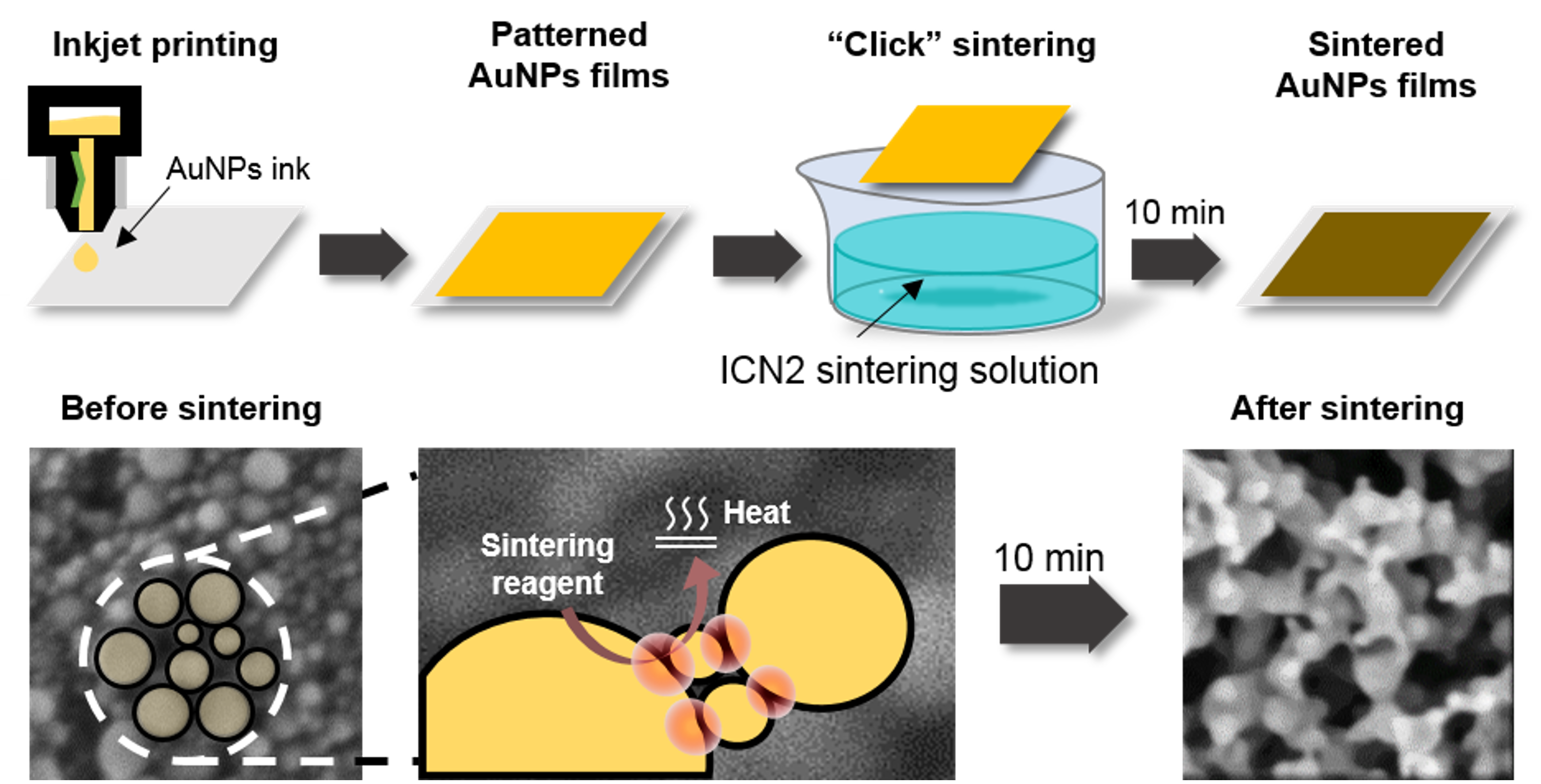Tuesday, 12 December 2023
Tune it in a ‘click’: a novel technique easily enhances the properties of nanostructured films for biosensors
In a study published in 'Small', a team of researchers led by members of the ICN2 Nanobioelectronics and Biosensors Group introduced 'click sintering', an innovative method to improve the properties of gold nanoparticle films instantaneously. This technique, which can be applied to a variety of substrates and does not require expensive equipment, increases the conductivity and nanostructuration/porosity of the films. It enables the fabrication of customised electrodes and surfaces for applications in flexible electronics and highly sensitive biosensors.

Nanoparticles of gold and other metals are extensively used in the nano-(bio)-sensing domain for their remarkable versatility and beneficial properties arising from their small size. Nano-structured and functional surfaces designed to meet specific needs and for different applications can be fabricated using metal nanoparticles –dispersed in a colloidal solution— and inkjet printing. The desired structures are printed on a substrate, which varies according to the application, and then a post-treatment called sintering is performed to improve their electrical and mechanical properties.
However, the techniques generally used to implement this post-treatment may limit the substrate options –paper and plastics, for example, are sensitive to thermal processing— and require expensive equipment, not available in all laboratories. In addition, these processes can cause the collapse of the pores and interstices of the printed film, limiting its nano-structuration. Alternative strategies to induce sintering of printed nanomaterials without incurring in these issues are therefore necessary, in particular for application on plastic or paper substrates, which are very relevant for flexible electronics and biosensors.
In a scientific article published in the latest issue of Small, a team of researchers –from the ICN2, the University of Teramo (Italy), the University of Pisa (Italy), and the company RHP-Technology GmbH (Austria)— presented an innovative, straightforward procedure, named click sintering, to improve the electrochemical and structural properties of the nanoparticle printed films, which does not compromise their nanostructures and is applicable to temperature-sensitive substrates. ICREA Prof. Arben Merkoçi and Dr Giulio Rosati, respectively the group leader and a senior researcher of the ICN2 Nanobioelectronics and Biosensors Group, are the corresponding authors of the paper, while doctoral student Massimo Urban (from the same group) is the first author.
In the click-sintering technique, a solution of sodium borohydride (NaBH4) is used to treat films of gold nanoparticles (AuNPs). This agent induces an unexpected catalytic reaction on the surface of the gold nanoparticles that enhances the nanostructuration of the AuNPs films boosting their conductivity, mechanical strength, and porosity. No expensive tools and solvents or external sources of energy are required. As demonstrated by the authors of this work, click sintering enables easy fabrication of tailored electrodes and functional surfaces for a variety of applications, such as electrochemical biosensors.
The properties of the conductive and electroactive nanoporous film produced with this method can be tuned by changing the concentration of NaBH4 and the reaction conditions. A further improvement in the direction of automatization is also envisioned, as the sintering agent can be “printed” in a second step on top of the gold electrodes, using the same inkjet printer. This groundbreaking research makes use for the first time of a catalytically induced sintering as a tuneable nanostructuration mechanism, which can produce relevant impact on the fabrication of flexible electronics and more sensitive biosensors.
A patent application has already been filed –and is currently under evaluation– to cover the intellectual property of this invention. Commercial exploitation of the click sintering technique is in the future programme of the authors of this remarkable study.
Reference article:
Massimo Urban, Giulio Rosati, Gabriel Maroli, Flavio Della Pelle, Andrea Bonini, Laszlo Sajti, Mariangela Fedel, Arben Merkoçi, Nanostructure Tuning of Gold Nanoparticles Films via Click Sintering. Small, 2023 (Epub ahead of print). DOI: 10.1002/smll.202306167.

